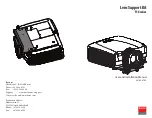
60
The signal-to-noise ratio should be approximately the same for each pair. If the signal-to-noise ratio
drops for any particular speaker, or a particular look-angle, or a particular ear, then it may indicate a
problem with the measured data, and the measurement may need to be re-taken.
The subwoofer channel will normally have a significantly lower signal-to-noise ratio than the full-
bandwidth channels, as illustrated by channel 4 above.
The second diagnostic screen shows the approximate inter-aural delay (delay between left and right
ears), in samples, for each impulse response in the PRIR data set. The data is arranged in order from
channel 1 to channel 8, and each channel shows the inter-aural delay for the measurements taken at the
three head positions.
For example:
13 03 26 15 24 01
00 13 15 12 23 23
18 30 05 16 04 32
xx xx xx xx xx xx
This is interpreted as:
Channel 1 = 13 03 26 Channel 2 = 15 24 01
Channel 3 = 00 13 15 Channel 4 = 12 23 23
Channel 5 = 18 30 05 Channel 6 = 16 04 32
Channel 7 = xx xx xx Channel 8 = xx xx xx
The physical speaker that each channel numbers refers to depends on the actual speaker configuration.
In this example, the channels are at the default assignments and it is a 5.1 system, so channels 7 and 8
were not measured.
Within channel 1 (the left speaker), the three sets of inter-aural delays are 13, 03 and 26.
13 = inter-aural sample delay, looking centre
03 = inter-aural sample delay, looking left
26 = inter-aural sample delay, looking right
For the left, right and centre speakers (channels 1, 2 and 3), one of the delays should be close to zero
(values 03, 01, and 00 above), since the subject will normally be looking directly at these speakers
during the measurement procedure. If the number is larger than expected it implies that the subject was
not orienting the head correctly, though it should be noted that people’s ears are not exactly equidistant
from the nose, and for some, the asymmetry is significant.
The left and right speakers (channels 1 and 2) should also display some symmetry; that is, the inter-
aural delay of the left and right speakers should be equal for looking centre (values 13 and 15 above),
and the inter-aural delay of the left speaker looking right should nearly equal the inter-aural delay of
the right speaker looking left (values 26 and 24 above).
The centre speaker (channel 3) should have similar delays for looking left and looking right (values 13
and 15 above).
The values for the
SW
speaker (channel 4) are not important (12 23 23 above).
In all cases, if the numbers are inconsistent it implies that either the subject was not oriented correctly,
or that the data was measured incorrectly, and the measurement may need to be repeated.
















































